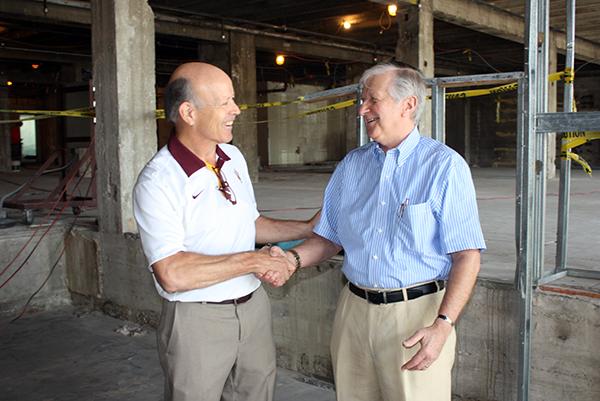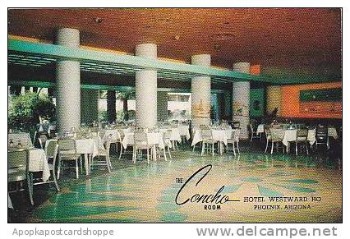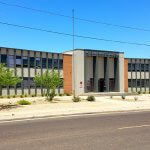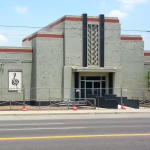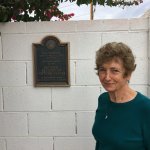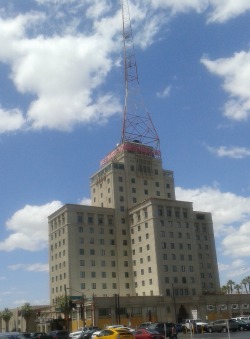 This fall, ASU will open an ambitious education and community outreach program in the ground floor of the historic Westward Ho in downtown Phoenix. The ASU Center for Applied Behavioral Health Policy in the College of Public Service and Community Solutions is leasing 15,000 square feet for 15 years and has some exciting plans for integrating their work into the Westward Ho community and strengthening their ties with downtown.
This fall, ASU will open an ambitious education and community outreach program in the ground floor of the historic Westward Ho in downtown Phoenix. The ASU Center for Applied Behavioral Health Policy in the College of Public Service and Community Solutions is leasing 15,000 square feet for 15 years and has some exciting plans for integrating their work into the Westward Ho community and strengthening their ties with downtown.
Dr. Michael S. Shafer, a professor of Social Work and the director of the Center, says they will relocate the faculty, student and staff offices to the Westward Ho and convert the historic Concho Room into the Community Education and Health Center.
“At the Center for Applied Behavioral Health Policy,” says Prof. Shafer, “we do a lot of continuing education work for all sorts of health and human services professionals – from judges and probation officers to drug counselors and mental health counselors.” He points out that over the nine years that the Center has been affiliated with ASU they’ve had a really hard time hosting these kinds of training events on the Tempe campus. “One of our design imperatives at ASU is ‘the power of the place’ and bringing the community into our space (at the Westward Ho) is part of that transformative experience.”
“The Concho Room will become our dedicated space for hosting community engagement meetings, continuing education trainings and smaller scale conferences and convenings,” says Shafer. “And most exciting,” he adds, “we are creating what we’re calling a supportive services clinic: a student-staffed, faculty-supervised clinic that will initially be restricted only to provide services to the 300 tenants that call the Westward Ho their home.”
The clinic will bring together four disparate academic units, including social work, nursing, recreational therapy, and nutrition and health promotion. They currently have faculty from each of these departments working together on the design for the clinic, which they plan to launch in August. “All four of those disciplines have requirements among their undergrad and grad students for practica and internships, etc. and it’s a very natural leap for ASU to meet the needs of that community,” says Shafer.
A doctoral student under Shafer’s supervision surveyed fifty of the tenants at the Westward Ho to assess their needs. “What we discovered was that, surprisingly, they have pretty good access to healthcare. 80-90% of the tenants surveyed reported that they’d had a scheduled physical exam in the last year, which is a very good marker of healthcare access.” They did find that tenants have a lot of chronic health issues that need attention, but, “more importantly, we discovered these folks were largely, isolated, self-isolated, cut off from community and forgotten.”
Rhode Island-based PAG-CDG has developed and operated the property as a HUD facility since 1979, and according to Shafer, they have done a terrific job in maintaining the building and providing a valuable service. But the HUD funding they receive is tenant-based vouchers, which means strictly vouchers to lease an apartment. They aren’t given any funding to provide supported services on site. Consequently, there is a lot of social disorganization and chaos.
“The most recent data we were able to get from the city police and fire departments indicated that in 2012 they’d had over 600 dispatches to the Westward Ho between them. 600! That’s more than two per day.” He adds, “I’ve worked for over 20 years in this public funded behavioral health space, and so we spend a lot of time around areas of homelessness, criminal justice systems, and mental health and substance abuse treatment. For years we’ve known that this (the Westward Ho) has been a kind of ‘no man’s zone.’ No one has tried to address the issues there.”
Shafer describes a three-fold agenda for the clinic.
“First and foremost we want to create a state-of-the-art, easily accessible training environment for our students. Second, we want to improve the quality of life for the tenants, and third, just like a teaching hospital, the tenants participating in the clinic have the potential, and I emphasize ‘potential,’ to become research subjects to secure federal funding to study how to improve the health and quality of life in the elderly living in place.”
Shafer sums it up this way – “the core of every university is the generation of knowledge that helps to transform community.”
He underscores that “the tenants will be front and center in helping direct the research. The questions and how we address those questions will be directed by the residents and the downtown community.” He ASU team is currently putting together an advisory panel of community leaders to help them effectively engage with downtown.
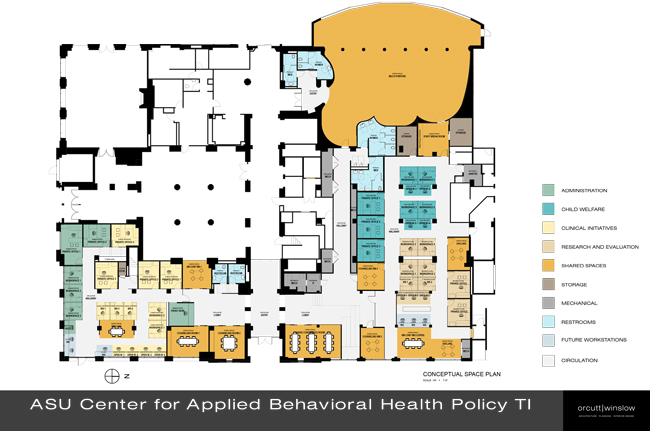 So what’s the current progress on the renovation of the space and the planned move? “We’re about 60% through on the demolition, so there’s still a lot to do before we go into soft opening and relocation in time for the fall semester.” They will probably wait until October to do any kind of big grand opening, but students, faculty and staff will be in the space when the fall semester begins.
So what’s the current progress on the renovation of the space and the planned move? “We’re about 60% through on the demolition, so there’s still a lot to do before we go into soft opening and relocation in time for the fall semester.” They will probably wait until October to do any kind of big grand opening, but students, faculty and staff will be in the space when the fall semester begins.
And what about the historic nature of the Concho Room? How much will they preserve? Shafer assures me that they’ve embraced the preservation element. “The Westward Ho is on the national registry and you still have the art deco feel of the room,” he says. “In fact, If you blink twice you can almost see the Rat Pack up on the stage and – that’s going to stay. The basic shell will remain, and for people who were entertained in there – the dance floor will remain.”
It’s worth noting that as a result of ASU’s lease, the owners were successful in securing a supportive housing tax credit, so they are undertaking some pretty major renovations on their own, including replumbing the entire towers. They’ve also extended another 20-year commitment to HUD.
While they are still working out the details of how the clinic will be managed, for the last four or five years undergraduate nursing students have been staffing a clinic in the Westward Ho for one or two days a week. This new, greatly expanded program will incorporate social work, nursing, nutrition and recreational therapy.
“We also look forward to helping the tenant advisory council have some functionality and robustness. With it being managed from Rhode Island, there is a real disconnect there,” says Shafer. “A lot of our work is going to be about asking ‘how do we create a sense of community among you and in support with you?’ Students in social work who are training to become clinicians will have a terrific opportunity to practice and learn their counseling skills.”
The average age of the tenants in the Westward Ho is 59-64. Tenants must meet the HUD criteria, which means they must be homeless or at risk of being homeless, and they must meet a low-income threshold. Shafer adds, “Up to 50% of the tenants have some form of diagnosable mental health condition, chronic disease, diabetes, hypertension, or are mobility impaired.”
The program should bring a tremendous benefit to the tenants and the downtown community. Shafer has also been in conversation with Dean Tepper of the Herberger Institute for Design and the Arts about the intersection between the arts and recreational therapy. “We’ve had some wonderful conversations about how we might also use the Concho Room as an event space for their students and faculty – perhaps for recitals, exhibitions, etc.”
The new Center will be great for ASU, for the Westward Ho tenants, and for downtown as a whole. It will be exciting to watch the program develop and discover new ways for the Westward Ho to better serve its tenants, be a useful training ground for students, provide potential research opportunities for faculty, and offer continuing education opportunities for social welfare professionals.




